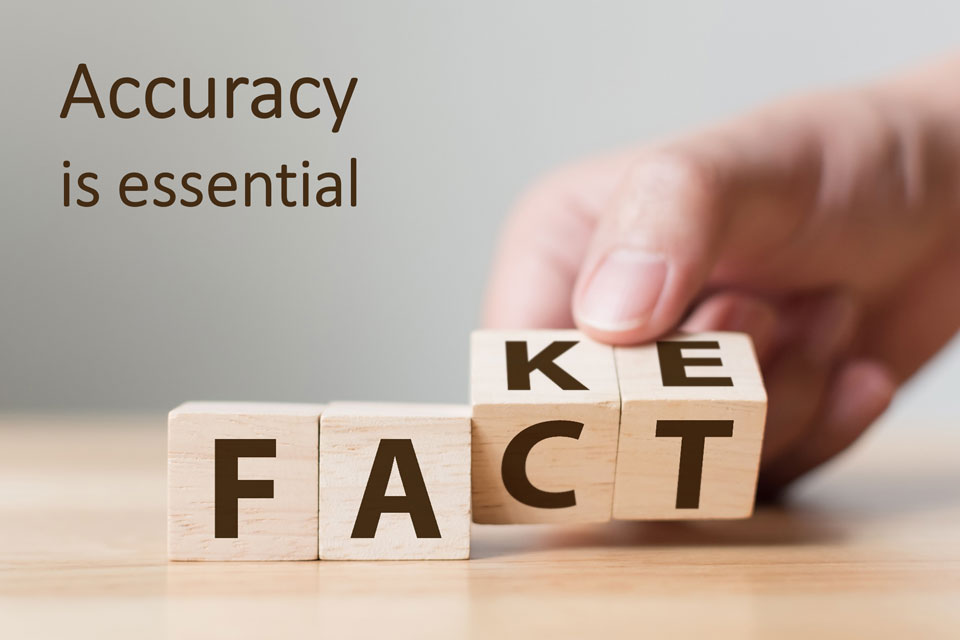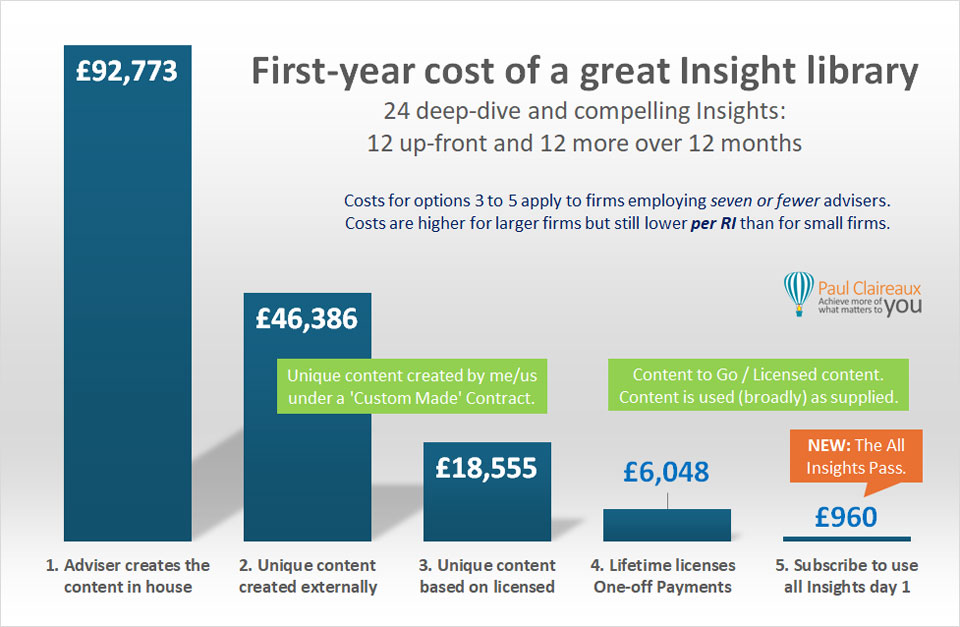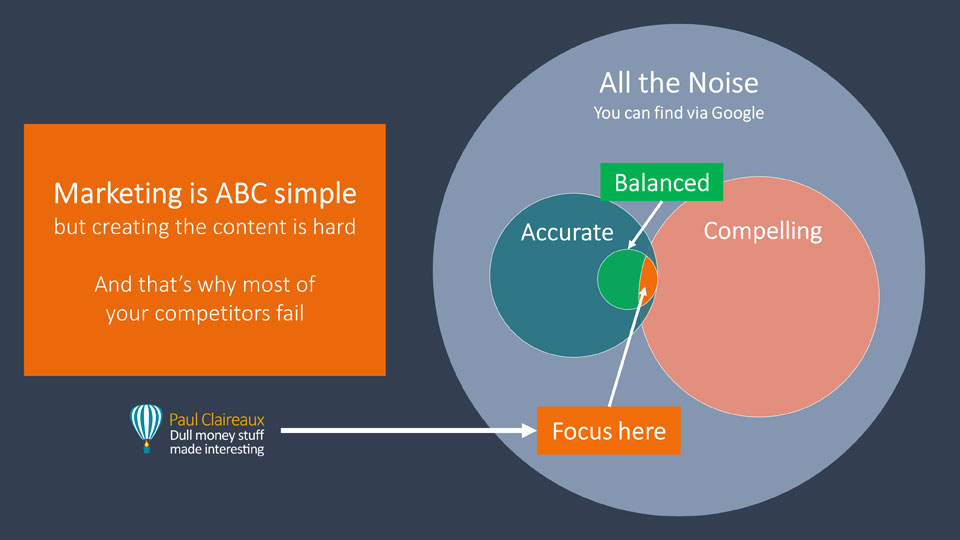Six ways to rate a content creator (Part 1)
Is their content Accurate, Balanced and Compelling?

This (7 to 15-minute read) is the first of two Insights for owners of Financial Planning, Advice, or Coaching firms.
Across these two Insights, I’ll outline six hard questions for rating the services of any potential content creator or supplier.
The first three questions and some wider points are covered in this Insight.
The other three questions are covered in Part 2, where you’ll also find content ideas designed to help you with your unique marketing challenges as a financial planner, adviser, or coach.
On the way, of course, I answer all six questions as they relate to my services.
If you’d prefer to talk rather than read about this challenge of content supplier selection, you can book directly into my diary here.
I really don’t mind who you use as a content creator or supplier.
I just want them to serve you (and your clients and prospects) brilliantly!
And, the truth is, not all of them do that consistently.
What can I assume about your marketing knowledge?
I know assumptions are dangerous.
When we ASSUME, we make an ASS out of U and ME!
(This funny explanation was offered by the character ‘Felix’ in the 1970s TV series ‘The Odd Couple’)
However, I want you to get great value from these posts, so I will assume that:
- You’re considering working with a Financial Education content supplier – either for the first time or to replace (or work alongside) one you work with today.
- You’re fully aware of the 25 ways in which Education-First marketing can benefit your firm, your team, your clients and your professional introducers. (If you’re not, please read this post first)
I’ll also assume you’re aware of the potentially eye-watering costs of creating a ‘go-to’ library of Educational Insights without any outside help.
If you’re not, please read this other post when you have time.
The key numbers are shown in this chart.
For all the assumptions behind this chart, e-mail me at hello@paulclaireaux.com with the subject title, ‘Chart Assumptions’
And I’ll send those to you by return – they’re all perfectly sensible.
How many firms spend £100,000+ on content – in a year?
 Very few small firms but quite a few larger ones.
Very few small firms but quite a few larger ones.
And to cut to the bottom line…
My NEW services aim to help small firms access the same (or better!) quality educational content as big firms – but at a fraction of the cost.
Sound interesting?
Trust me, the costs, in the bar chart above, are real.
Indeed, the numbers on the left (option 1) are a conservative estimate for firms which create a great library.
Sadly, a great many small firms start projects to build an educational library without knowing this.
So, it’s only when those cost realities start to bite that many re-think the plan or give up.
Yes, some stick at it and build a good library.
Pete Mathew is an excellent example of someone who’s committed his life to financial education.
But Pete’s level of passion for this is exceptional – it’s not the norm.
The truth is that the costs and pain of crafting enough (high quality) content for a great library are too much for most.
And those costs are way too much for most small and growing firms – where the day job must come first.
So, a great many well intentioned educational content projects stall or only progress in fits and starts.
And I’m passionate about helping you offer a great content library without any of that pain.
Is licensed (off-the-shelf) content the only low-cost answer?
No, not at all.
Some firms opt for Custom-Made Content instead of (or in addition to) any Ready-Made (licensed) Money Insights they share with clients and prospects.
So, there are established markets for both types of works.
It’s the extremely high cost of creating content in-house that drives firms to outsource either ‘custom-made’ or ‘ready-made’ content.
The pricing dynamics are simple enough.
Most Professional Content Creators charge a lot less than an adviser giving advice by the hour.
In my case, on ‘Custom Made Content’ contracts, I save my clients between 40% and 85% of their time costs to create similar content in-house.
And my clients tell me it’s not just the cost savings – they gain on content quality too.
The actual saving depends on three things:
First is the advisers effective fees. This is the amount you (or the planner you assign to content creation work) could earn by advising instead of writing content.
According to VouchedFor, the number is £200 per hour for an average adviser, but it’s far more for some and a bit less for others.
Second there are my fees: These are transparent and, where I work on custom made contracts, tend to be between 40% to 70% less than the fees of an adviser.
Third, is our approach to content creation. Do you really need 100% brand new and bespoke content on every topic – or would content that’s unique to you but based on my licensed content work well for you?
I’m finding increased interest in Option 3 (in the chart) where I create tailored versions of my standard content for firms.
This gives them a degree of content uniqueness (where that’s important – and we can debate that) while saving a ton of money vs having 100% custom made works.
Of course, on any Custom Made Content contracts, I also save business owners from almost all of the thinking work that comes with content creation.
There’s a lot of intense work here – from developing ideas, structuring, drafting, and editing the content, to creating or sourcing the images.
Only ‘almost all’ the work?
Yes, you still need to read and sign off on the finished works!
Anyway – if you feel you might need some custom-made consumer-facing content, let’s talk.
Less content (and licensed content) costs less.
The chart I show above assumes that you’ll build or acquire a substantial library of 24 long-form Insights over the course of a year or two.
But perhaps you’re happy with a more modest-sized library – or you have half a good library today and just want to build it up to being a ‘go-to’ place for answers.
Either way, if you want, say, 12 more long-form Insights for your library, you can halve the cost numbers in options 2 to 4 of that chart above.
Just remember that any (high-quality) library of 100% new and unique content (option 2) will still cost a chunk of cash.
So, nowadays, alongside (or instead of) my custom-made contracts, I offer licensed content – which enables advisers to offer excellent-quality insights to consumers at significantly lower cost.
Frankly, there is nothing not to like about the new licensed content services I offer.
Do you avoid licensed content because of quality concerns?
I can certainly understand if you do.
You could seriously damage your firm’s reputation if you share content that’s either boring, repetitive, flawed or misleading.
And, let’s be honest, some content from some suppliers does fail in some of those areas.
That’s why you need a sound process for rating potential content suppliers, which we’ll come to next.
For now, I assure you that I work tirelessly on my licensed content.
It all undergoes rigorous quality tests and is every bit as good as the content I create on a custom-made basis.
Shall we move on to those 6 simple tests?
I love a good mnemonic – don’t you?
Need to recall the right order for the Colours of the rainbow?
Richard Of York Gained Battles In Vain.
Red, Orange, Yellow, Green, Blue, Indigo, Violet.
How many days are there in this month?
30 days hath September, April, June and November, etc.
If, like me, you’re passionate about education, you’ll know mnemonics support efficient learning and extend our memory of ideas.
So, I offer mnemonics in my Money Insights, and I’ll share some examples in the next post.
For now, let’s dive into these six tests to rate content suppliers.
They’re easy to remember; each test starts with a letter from A to F.
Here are the first three:
Some of my Chartered Financial Planner friends love these ABC tests.
They’re certainly easy to remember, but let’s not kid ourselves – these are extremely hard tests to pass.
It takes an enormous amount of work (even with the best AI tools – which I use) to create content that’s 100% Accurate, Balanced, and Compelling.
However, this is the quality of consumer-facing content that financial planners, advisers, and coaches require, so:
- Every Insight I supply is reviewed by at least two leading financial planners – one of whom used to mark exams for the Institute of Financial Planning.
- My Money Mindset pieces are checked by an acclaimed Doctor of Psychology with 20 years of clinical experience.
- All my content is reviewed by a communications specialist, who takes a non-expert consumer perspective. (A hard task master who ensures every sentence is clear and jargon-free!)
Is all this effort worth it?
You must decide after reading this and some of my consumer-facing works, like this one, perhaps.
In the meantime, you may want to read my testimonials here.
How do you *inspect* content from suppliers today?
 Do you take time out – to focus closely on it, and ask these hard questions?
Do you take time out – to focus closely on it, and ask these hard questions?
Or do you assume (that word again!) that all the consumer content you pay for is excellent quality?
Is it all excellent?
Really?
Who else in your team, or your family, do you ask to critically review the content you’re sharing with your clients, prospects and professional connections?
I get it.
You have enough to do – running a business.
I work with many business leaders, and few have enough time to carefully check the quality of the content their firm shares with consumers.
And that’s fine if you have others who fully capable of checking those words and pictures for you.
If you don’t, I urge you to ask for help from someone who is.
The situation you must avoid is where your clients or professional connections are the first people to find errors in your content!
Very few, if any, will tell you.
Instead, they’ll just drift away.
Over time, you could spend a fair amount of money with a content supplier.
So, please test them with these six questions.
Ideally you’ll ask these questions before you start using a content supplier, but if you already use one, start asking these questions now and on an ongoing basis.
You might not know it now – but your business reputation depends largely on the quality of content you provide to your clients.
And if you set a low quality bar for your suppliers, now is the time to raise it.
Now, let’s look more closely at the first three of these six questions.
And, as I’m using an A to F mnemonic for this list, we’ll start with the letter ‘A’
‘A’ asks if the content is Accurate.
 You know that the financial well-being of your clients rests on the integrity of your (or your team’s) guidance or advice.
You know that the financial well-being of your clients rests on the integrity of your (or your team’s) guidance or advice.
So your content must be 100% Accurate.
If it’s not, you’re putting your client’s well-being and your reputation at risk.
Any flaws or biases in your content will only serve to undermine trust in your services among clients, their family and friends, and other prospects.
Your client’s Solicitor or Accountant (and others who introduce clients) are also more likely than your non-expert clients to spot flaws in any content shared.
And, of course, you face regulatory risks if you share misleading ideas with consumers.
So getting your content right is a high-stakes game.
‘A’ is for Accuracy and is your first supplier rating factor.
‘B’ asks if the content is Balanced
Half a truth is still a whole lie.
Benjamin Franklin, 1735.
Offering Accurate content is a good start, but to be taken seriously and deliver on the Consumer Understanding Duty, our content must tell the truth and the whole truth.
I’m sure you don’t want content that tilts messages to suggest a particular course of action.
If you do, I’m the wrong guy for you!
Those are sales pitches or financial promotions – and have no place in a sound educational library.
I’m acutely aware that you can only make recommendations after you ‘know your customer’
(I’ve passed the financial planning exams and used to be a wealth manager)
So, I create content that educates and informs.
It doesn’t pitch or sell any financial product or investment idea.
Telling the whole truth is essential on questions of money and investing.
The client’s financial security (or that of their loved ones) is at risk if we get this wrong.
So it saddens (and maddens) me to see content shared with consumers that’s either inaccurate or imbalanced.
And I’m sure this frustrates you too.
What problems do I see with ‘some’ content?
Well, sometimes it’s ‘just’ a few typos.
But at other times it’s much, much worse.
Pretty but poorly constructed charts in colourful guides are quite common.
It’s easy to see when they’ve been created by someone with ‘design skills’ but no knowledge of financial planning or how to present numbers in a fair and balanced way.
One content provider is a ‘horror’ on this front.
The fact is there are still too many inaccurate, imbalanced and misleading ideas shared with consumers.
If you’d like to talk, I could tell you how I persuaded the senior management of one of the world’s largest fund managers to remove misleading content from their otherwise excellent content for advisers. This was a classic case of managers accepting the error when it was pointed out – but claiming they didn’t have time to check what their marketing people were doing!
And this is not an isolated case; the misleading idea they used to share is still shared by other fund managers and support service providers.
I’m working on those too – and unhappy about doing the FCA’s job for them… unpaid!
Anyway, I urge you to avoid falling into that trap.
Check the accuracy and balance of the content you share.
And if you need a second opinion on a sample of content, don’t hesitate to ask.
I’ll happily offer that!
This is about building trust with your clients and other stakeholders.
My work life mission these days is to help you do this.
To become (or maintain your position as) a Trustworthy ‘go-to place’ for consumers to find answers on the vital money questions.
People’s initial perception of us comes first from our warmth (our intentions) and then from our competence.
(I’ve added reliability as a multiplier because that matters most over the long term)
If we offer misleading money lessons, we undermine our prospect’s perception of our intentions and our competence!
And that destroys trust.
We need to show expertise, experience and authority.
And, unsurprisingly, Google knows these things matter most to consumers too – more here.
‘C’ asks if the content is compelling
 Offering content that’s accurate and balanced is essential, of course.
Offering content that’s accurate and balanced is essential, of course.
But that alone only gets us an entry ticket to the Content Club.
If content is worth creating (or paying for), it must grab our attention and trigger emotional responses.
In short, it must resonate and detonate in our audience’s minds.
This requires every sentence to be crafted and refined by a creative human mind!
Not (just) by a Robot – clever though they are.
So, you don’t want a supplier which churns out content for the sake of it.
Nor do you need one who thinks the goal is to hit a particular word count.
That gives you dry, repetitive and padded content.
And you really don’t want that.
You need to share content that does these things:
 You’ll want to provoke these emotional responses to different degrees at different times.
You’ll want to provoke these emotional responses to different degrees at different times.
Just like they do in a great film.
This type of content requires time to create.
So, if you opt for custom-made content, don’t pay by the word count – pay for time spent to encourage the creation of compelling works.
This is how the best writers charge.
And yes, they’ll offer price caps on their work to ensure you stay within budget.
Heck, if you’re lucky, they might even offer you some low-cost licensed versions of their best quality works.
You can then keep your costs down by mixing those Insights with any bespoke works you offer.
Are you wasting your money on content?
 It’s seriously hard work to create Accurate and Balanced consumer-facing insights on money (and money psychology) questions.
It’s seriously hard work to create Accurate and Balanced consumer-facing insights on money (and money psychology) questions.
But all that work (or content cost) is wasted if no one engages with the ideas you share.
The truth is that most people (expert or otherwise) ignore boring content.
Research from Nielsen (the ‘User Experience’ experts) found that even highly educated professionals (scientists, medical experts, technologists) favour clear and scannable information.
Others, who led the great work to redesign GOV.UK (have you noticed how it’s understandable now?) discovered the following:
“the more educated the person and the more specialist their knowledge, the greater their preference for plain English”
So, we have all the evidence we need.
And don’t be fooled by those gurus, building trust with marketing is not about choosing videos over text-based posts.
I have no axe to grind here; my content gets used for both.
That’s why I write in a conversational style.
You don’t want to pay twice for the same messages in different formats, do you?
The point is, you must not offer content that blurs into the sea of financial services grey.
If you do, you will lose clients to firms with more compelling ideas.
Very few prospective clients stay long on websites unless they’re engaged.
And once they’re bored (or sense they’re being misled) there’s almost no chance of them returning or recommending your site to their friends or family.
Sorry, but that’s just how this goes.
The risks are high if your content is misleading, confusing or boring.
So look hard at it against these ABC tests.
Or hire someone to help you with that.
Coming next
I hope this first Insight has got you thinking about how to choose a great content creator.
Part 2 with the other three tests is here – when you’re ready for that.
Want to stay in touch?
Want to be kept up to date with my services – and NEW consumer-facing Insights as I add more to my library?
Then sign up for my Educators Newsletter
And if you’re interested in my NEW ‘All Insights Pass’ content service, email me at hello@paulclaireaux.com so I can tell you as soon as the (crazy) £80 per month launch offer goes live.
Please note that the £80 per month price will never increase in real terms if you grab it while it’s on offer.
Future new subscribers will pay 50% more in the future, as the library grows.
So, if you feel that my content could help your business, grab a place for the low (and fixed) offer price while it’s available.
Or to discuss this or my other services, feel free to book a meeting in my diary here.
All the best for now.
Thanks for dropping in.









Discuss this article